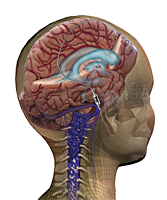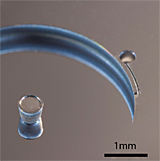Updated brain valve releases the pressure
The condition creates dementia-like symptoms and affects around 2,000 Swedes each year. We are referring to an excess of cerebral fluid because of a defect in the flow of cerebrospinal fluid. A solution where a valve is surgically placed behind the ear has previously resolved the issue, but it appears that the valve after just a few years often clogs up completely and must be replaced. The KTH researcher has now found a solution and can thereby introduce Hjärnventil 2.0 (Brain valve 2.0).

The diagnosis is called NPH, an abbreviation of Normal Pressure Hydrocephalus, and produces major problems for the patient. Quite often it is mistaken for incurable diseases like Alzheimer’s or Parkinson’s.
“The problem in fact is an excess of cerebral fluid. It creates, among other things, dementia-like symptoms such as incontinence and balance problems. This affects 1-2 per cent of those over 60 years of age,” says Niclas Roxhed, researcher at the Department of Microsystems Technology at KTH.
To solve NPH, scientists have figured out that it is possible to divert the amount of cerebrospinal fluid from the brain when there is an excess. The valve therefore acts as a drainage system and leads the cerebrospinal fluid into the stomach, where it is absorbed.

It could have ended happily, had it not been for the problems that arise after a few years.
“The problem is that the valve sometimes stops working after a few years, and a surgeon has to replace it. Proteins simply clog the valve up, but sometimes the tubes come loose and other mechanical failures occur,” says Niclas Roxhed.
To solve this, he and his research colleagues are developing a valve based on so-called MEMS technology, which will not be affected by protein plugs.
“The solution currently in operation is not based on MEMS technology. The new updated valve is however. The clever thing with the valve, besides the fact that it does not clog up, is that there is no discharge of material. Moreover, it is so sensitive that it doesn’t matter whether the patient is standing up or lying down, which is an advantage,” says Niclas Roxhed.
He adds that he and associate professor Anders Eklund along with their colleagues at Umeå University are developing new prototypes right now. Then only clinical tests of the new valve remain.
For more information, contact Niclas Roxhed on 08 - 790 91 43 or niclas.roxhed@ee.kth.se.
Peter Larsson

